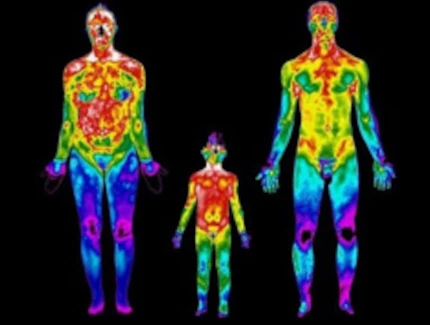
Image: A relatively stable and elevated body temperature helped maintain some level of metabolic performance and activity, even when environmental conditions were less clement. Homeostasis (temperature maintenance) is crucial for the optimal functioning of cells, tissues and organs.
The body temperature of 37 °C, slightly different from person to person and time of day to day, is a general average for human beings. This temperature is the result of a subtle balance between several evolutionary and functional factors.
Many chemical reactions that occur in our body are accelerated by enzymes, which lower the activation energy required for the reaction to take place. Most of these enzymes have an optimal function at a temperature around 37 °C, that which corresponds to an atomic agitation which allows the stability of macromolecules. Thus, this temperature makes it possible to ensure a maximum reaction rate for many metabolic reactions.
Metabolic reactions are the chemical processes that occur in the cells of our body to sustain life by performing functions such as energy production, molecule synthesis, cell repair and repair. cell renewal (essential process to maintain the integrity of tissues and organs).
Moreover, many immune reactions, such as the release of cytokines and other signaling molecules, are facilitated at a temperature close to 37 °C. These reactions are crucial for coordinating the immune response, inflammation and communication between different immune cells.
White blood cells (leukocytes) are key cells in the immune system responsible for detecting and eliminating pathogens (bacteria, viruses and other germs). Many types of white blood cells, such as neutrophils, macrophages, and lymphocytes, function most efficiently at a slightly elevated body temperature. The high temperature improves their mobility, their adhesion to infected cells and their ability to phagocytose (absorb) pathogens which are better adapted to near-normal body temperatures.
Thus, to fight against pathogens, the body becomes feverish. At this time, body temperature generally rises to 38-39°C and sometimes even up to 40°C. Enzymes are proteins that catalyze biochemical reactions in living organisms. Their activity is closely linked to their three-dimensional structure, which is sensitive to environmental conditions such as temperature. At approximately 40°C, enzymes in many organisms, including humans, maintain a stable conformation that is optimal for catalysis. At lower temperatures, the structure can become too rigid, decreasing enzyme activity. At higher temperatures, the structure can denature, disorganizing the active site and inhibiting enzymatic activity. The normal human body temperature is around 37°C and human enzymes have evolved to be optimal near this temperature. However, the optimum is at 40°C because this allows, without inhibiting enzymatic function, a certain margin of safety in physiological conditions, such as during fever. The living thing maintains a margin of maneuver to remain robust and from time to time it engages in performance to defend itself.
In short, this body temperature between 36.5 °C to 37.5 °C is the most relevant for our organism. Our body is constantly engaged in regulating body temperature to maintain optimal thermal balance.
Modern humans, Homo sapiens, originated in Africa and evolved in this environment over time.
The climate and environment in which a species evolves have a significant influence on its adaptations and development. It is possible that the human body temperature of 37 °C played a role in the evolution of humans in Africa.
Tropical and subtropical regions often offer a wide variety of foods, including fruits, vegetables, and sources of protein. The "living" overall, works best at tropical and subtropical temperatures.
A body temperature of 37 °C therefore favors the metabolism and digestion of these foods. Homeostasis is crucial for the optimal functioning of cells, tissues and organs.
Early humans evolving in Africa may have benefited from a body temperature that favored metabolic and immune efficiency in a hot environment. Additionally, a slightly higher body temperature during waking hours promoted alertness and cognitive function.
In other words, a relatively stable and elevated body temperature helped maintain a certain level of metabolic performance and activity, even when environmental conditions were less clement.
Due to metabolic activity, our body produces a lot of heat and it is imperative to dissipate this heat to avoid overheating. Body temperature must be maintained within a relatively narrow range (36.5 °C to 37.5 °C) to allow chemical and biological reactions to take place optimally (phenomenon of homeostasis).
In addition, a body temperature of 37 °C represents a balance between heat production and the body's ability to lose it.
Indeed, excessive variations in ambient temperature can disrupt the structure and function of the body's components. But our body is involved in this regulation so that when the ambient temperature is lower than the body temperature, our body loses heat more quickly than it produces it. Mechanisms such as vasoconstriction (narrowing of blood vessels), muscle shivering, and piloerection (hair erection) are activated to generate and retain body heat.
When the ambient temperature is higher than the body temperature, our body loses heat more slowly than expected. Cooling mechanisms such as sweating and vasodilation (widening of blood vessels) are activated to dissipate excess heat and prevent overheating.
These thermal regulation mechanisms are examples of negative feedbacks, where the body attempts to maintain body temperature at an optimal level by adjusting physiological processes based on ambient temperature.
The average body temperature of 37 °C in humans is not directly related to the average Earth temperature in Africa or any other region. It is mainly influenced by biological and physiological factors internal to the organism.
However, the optimal body temperature selection of 37 °C is certainly the result of many other complex and interconnected factors as always in the living world.
Temperature likely evolved in response to a combination of physiological, environmental, and evolutionary stresses.
In addition, nature obeys a principle of energy saving, called in physics "principle of least action", and this relatively high temperature is perhaps the most energy efficient.
"When any change takes place in nature, the amount of action necessary for that change is the smallest possible." Maupertuis (1698-1759).